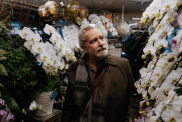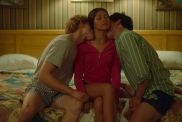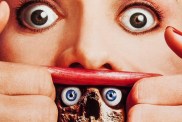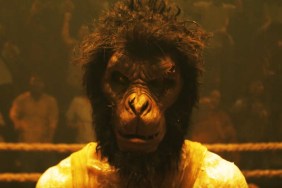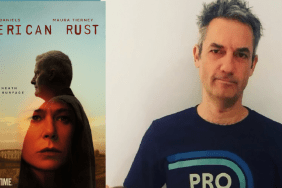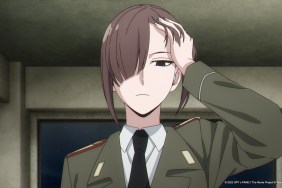In Part III of our Sky Captain and the World of Tomorrow set visit (read Part I here and Part II here), ComingSoon.net talks to visual effects supervisor Darin Hollings about bringing the action film to life.
Hollings provided us with a complete rundown of how the special effects were created:
We did a quick animatics robot and what that gave us was real world information about how to shoot the shots, gave us exact lenses, the camera positions, how far distance to subject, all that stuff. So I developed a system pretty much like a Thomas Brothers map and I built the stages we were going to shoot in in London, made a digital model, made a grid on the floor just like a Thomas Brothers map, numbers one way, letters the other way. So for every single shot, we made a map from our 3-D animatics where I knew camera was on G-11 pointing in a certain direction 12 degrees down with a certain lense on it. Gwyneth was on H-12 and she moved to like G-1. So for every single shot, we had a map and I had a survey team so we knew what we were doing every day, and I could even know ahead of time if they were going to go off the blue screen. So the D.P., once I made all these maps, the D.P. wasn’t happy about them because he cared where the light was coming from and I cared about where the camera and the blue screen was. So it was a big battle between us. Of course, we wanted to shoot it one way and then you have to start factoring in costume changes. So that was how we got from the 3-D animatics to shooting the live action.
What we did here, you can see the remnants. We had a bluescreen stage here and what we did was we kind of did dry run throughs with doubles for a lot of the movie. We had a Gwyneth double and a Jude double and we set up the camera and we shot the whole movie HD with a Sony F-900. So we calculated all this stuff, made sure our distances were proper, so we did dry run throughs of about half the movie back here. Everything we could shoot, we did shoot, so we kind of tested out all of our theories about how the whole process was going to come together. So then once we got all that live action shots, we came back here and then it was a matter of, mostly every shot that we shot on stage wasn’t exactly as the animatic was, so we had to track it and then replot those cameras and then build all the environments, render the environments, et cetera, et cetera. Then it’s pretty much standard visual effects from there where you’re putting blue screen actors into either a photographic background or a 3-D background.
One of the interesting things about this movie is when we set out to do this movie, Kerry had predicted about 70% of our backgrounds would be photographic. If they were in the jungle, we were going to find what lens we were and go shoot a jungle. 70% was going to be photographic, while 30% was going to be 3-D. But in the end, we found that just getting those photographs and finding those environments, whenever we went to a jungle or went someplace and shot it, it wasn’t exactly what Kerry wanted. So a lot of times to achieve his vision, we kind of had to build most of this movie in 3-D. So it became a little bit bigger of a challenge than we expected like that. The sequence you saw in Radio City, the director of photography and myself went to Radio City. We spent the day there with it completely empty and shot all the background plates. Then we went to London and shot Gwyneth and everyone in Radio City and it went together in nothing flat. So the things that we did do photographically went really fast. Obviously when you get into 3-D and you have to build these things virtually and make them look real, it’s a little bit slower.

One other interesting thing about the process is we actually composite in black and white, because our elements are coming from so many different sources. You have live action, you have HD, you have photographic elements and film elements. We use a lot of archival photos. Everything’s coming from completely different environments, different resolutions, so we get a black and white final first because the director wanted to do it in black and white at first. He only decided on color after. So we get a final black and white, and then we have a whole separate different team, a very small team and they go through and put the color into the movie. And what they do is they take the same after effects comp that the black and white compositors use. They open up the same column and they take all the colors from the different elements. They kind of lift them up, they kind of balance them into whatever palette we’re using for that sequence and then they kind of wash them over the black and white composite. So in essence, instead of these colors fighting each other, it’s kind of a glue that can help pull the whole thing together. Because we tried that. We composited everything separately in color, it just doesn’t work. So we actually do a black and white composite and do a separate color step after that and it gives it an interesting look. Actually, Kerry worked for a company called Color Systems colorizing black and white movies for years and I worked for a company called American Film Technologies colorizing all of Ted Turner’s movies. But this movie is not colorized per se because we actually are using the colors from the plates.
How is the team of animators divided?
This is kind of an interesting place because we crewed up from nothing. I worked for Disney and I called everyone I knew and then as I got people, they called people, and when we’re done with this movie, we’re done. So we have a small group of animators and our animation supervisor breaks things up to people’s strengths. Some are very good with organic things that might have a lot of organic movement and other people might fly planes around really well. So it’s kind of per animator as to what their strengths are. But we don’t have 500 people. We have 70 people here. We’ve got a chunk of the movie we’ve completed. Actually final a third. We’ve got another third in our pipeline here that’s at different states of completion and there’s probably another third that we’re outsourcing to all kinds of places around town to kind of get it done. There’s a place called Luma that’s doing our underwater battle and it looks really good.
Paramount’s Sky Captain and the World of Tomorrow flies into theaters on June 25.
